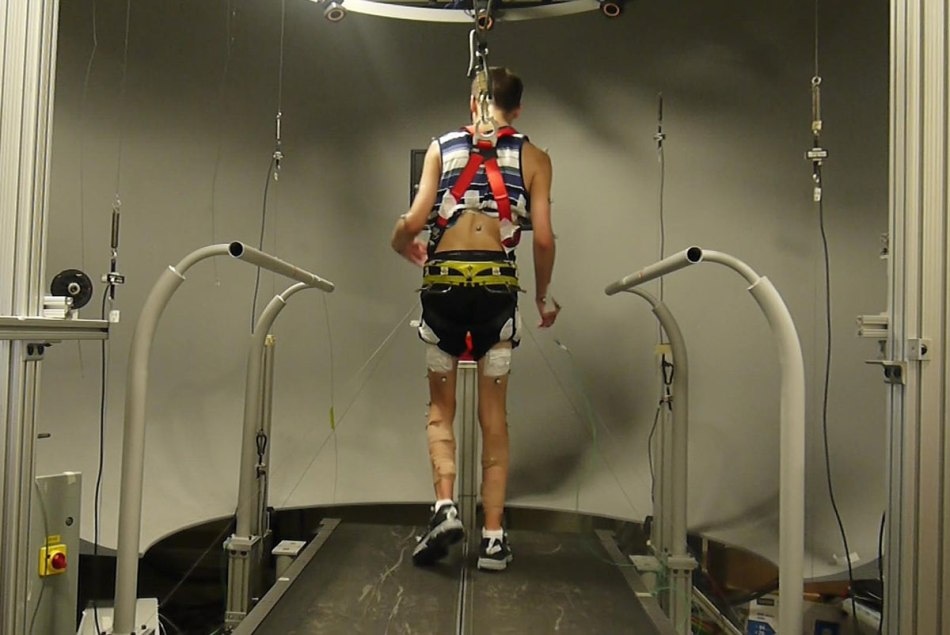Jul 27 2017
Cerebral palsy (CP) affects 3.6 out of 1000 school-aged children in the U.S. Their symptoms include irregular gait patterns which results in gradual joint degeneration. Reduced range of motion of the joints, slow walking speed, large body sway, small step length and absence of a heel strike are other problems that children with CP experience. A subset of these children exhibits crouch gait which is characterized by undue flexion of the knees, hips or ankles.
 Child using robot-driven TPAD training method to improve crouch gait, symptom of cerebral palsy. (Photo courtesy of Sunil Agrawal/Columbia Engineering)
Child using robot-driven TPAD training method to improve crouch gait, symptom of cerebral palsy. (Photo courtesy of Sunil Agrawal/Columbia Engineering)
In a recent pilot study in Science Robotics, a team headed by Sunil Agrawal, Professor of Mechanical Engineering and of Rehabilitation and Regenerative Medicine at Columbia Engineering demonstrates a robotic training technique that enhances posture and walking in children with crouch gait by improving their muscle strength and coordination.
Crouch gait occurs due to a combination of weak extensor muscles that do not create sufficient muscle forces to keep posture upright, coupled with tight flexor muscles that restrict the joint range of motion. Among the extensor muscles, the soleus, a muscle that can be found just below the knee all the way up to the heel, plays a vital role in preventing knee collapse during the middle of the stance phase when the foot is on the ground.
Vital to walking and standing, the soleus muscle maintains the shank upright during the mid-stance phase of the gait to assist extension of the knee. It also delivers the propulsive forces on the body during the late-stance phase of the gait cycle.
One of the major reasons for crouch gait is weakness in soleus muscles. We hypothesized that walking with a downward pelvic pull would strengthen extensor muscles, especially the soleus, against the applied downward pull and would improve muscle coordination during walking. We took an approach opposite to conventional therapy with these children: instead of partial body weight suspension during treadmill walking, we trained participants to walk with a force augmentation.
Sunil Agrawal, Professor of Mechanical Engineering and of Rehabilitation and Regenerative Medicine at Columbia Engineering
The research team knew that the soleus, the chief weight-bearing muscle during single stance support, is triggered more powerfully among the lower leg muscles when additional weight is added to the human body during gait. They rationalized that strengthening the soleus might assist children with crouch gait to walk and stand more easily.
To test their theory, the team used a robotic system — Tethered Pelvic Assist Device (TPAD) — invented in Agrawal’s Robotics and Rehabilitation (ROAR) Laboratory. The TPAD is a wearable, lightweight cable-driven robot that can be engineered to provide forces on the pelvis in a preferred direction as a subject walks on a treadmill. The Researchers studied six children diagnosed with CP and displaying crouch gait for fifteen 16 minute training sessions over a period of six weeks.
While the children walked on treadmills, they wore the TPAD as a lightweight pelvic belt to which a number of wires were connected. The tension in each TPAD wire was regulated in real time by a motor positioned on a stationary frame around the treadmill, according to real-time motion capture data from cameras.
The Researchers automated the TPAD to apply an extra downward force through the center of the pelvis to intensively retrain the activity of the soleus muscles. They used a downward force corresponding to 10 percent of body weight, according to the results of healthy children carrying backpacks. This was the minimum weight required to display remarkable changes in posture or gait during walking.
TPAD is a unique device because it applies external forces on the human body during walking. The training with this device is distinctive because it does not add mass/inertia to the human body during walking.
Jiyeon Kang, PhD Candidate and Lead Author of the paper
The team studied the children’s muscle strength and coordination using electromyography data from the first and last sessions of training and also observed kinematics and ground reaction forces constantly during the training. They discovered that their training was effective; it both improved the children’s upright posture and enhanced their muscle coordination. Furthermore, their walking characteristics, including step length, toe clearance, range of motion of the lower limb angles,and heel-to-toe pattern, became better.
“Currently, there is no well-established physical therapy or strengthening exercise for the treatment of crouch gait,” Agrawal notes.
Feedback from the parents and children involved in this study was consistent. They reported improved posture, stronger legs, and faster walking speed, and our measurements bear that out. We think that our robotic TPAD training with downward pelvic pull could be a very promising intervention for these children.
Heakyung Kim, A. David Gurewitsch Professor of Rehabilitation and Regenerative Medicine and Professor of Pediatrics at the Columbia University Medical Center
Going forward, the Researchers plan to conduct more clinical trials, to test a larger group and altering more variables. They are also thinking about researching children with hemiplegic/quadriplegic CP.
Robot-Driven Gait Training for Cerebral Palsy
Video showing how the robot-driven TPAD training method works to improve crouch gait in children with cerebral palsy. (Video courtesy of Sunil Agrawal/Columbia Engineering)
Agrawal Lab: TPAD Strength Training Effect
Video showing how the robot-driven TPAD training method works to improve crouch gait in children with cerebral palsy. (Video courtesy of Sunil Agrawal/Columbia Engineering)